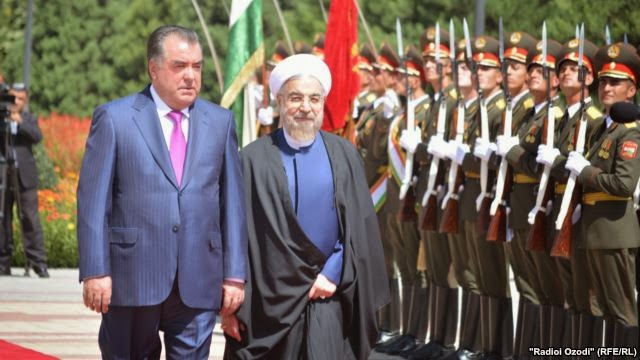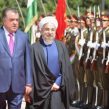
Shared Concerns Over Salafi Extremism Steer Iran and Tajikistan Into Security Agreement
Publication: Eurasia Daily Monitor Volume: 11 Issue: 166
By:

On September 11, Iranian President Hassan Rouhani arrived in Dushanbe, Tajikistan, to attend the Shanghai Cooperation Organization’s (SCO) annual summit (Ozodi, September 11). On the sidelines of the summit, Rouhani took advantage of his first trip to the small Central Asian republic to ink ten bilateral agreements. Throughout his visit, Rouhani’s public remarks emphasized Tajikistan and Iran’s shared history. At one point, he went as far as to comment: “Anyone who speaks Persian and anyone who understands Hafiz, Sa’di, Rudaki, and Firdousi [Persian poets] is an honorable citizen of Iran” (BBC Tajiki, September 11). Aside from flowery statements regarding Persian solidarity and promises to expand cultural and economic ties, the two countries also signed a bilateral security agreement. The details of the agreement were only discussed in broad strokes. However, Iranian state television’s Tajik-language service quoted Iran’s interior minister, Abdolreza Rahmani Fazli, as saying that the agreement would “increase cooperation in the fight against terrorism, extremism and narcotics trafficking, as well as intelligence sharing and training for border guards” (Tajik IRIB, September 11). If accurate, the agreement is noteworthy because security cooperation between Iran and Tajikistan has historically focused primarily on counter-narcotics, not border guard training—which has traditionally been the purview of Russian and US military assistance.
The agreement was likely the culmination of talks that occurred last month between the Iranian minister of intelligence, Mahmoud Alavi, and Tajikistan’s President Emomali Rahmon in Dushanbe (president.tj, August 11). A photo of the men shaking hands was published on several of Tajikistan’s state websites when the two reportedly met to discuss “an increase in security cooperation.” While public photos of Rahmon with Russian, Chinese or US military officials are not uncommon, meetings with Iranian security officials are typically less publicized.
The agreement, along with two high-profile meetings in the last month, may indicate the beginning of a closer security relationship motivated by a common interest in fighting Salafi-jihadist ideology. At a speech at Tajikistan’s Academy of Sciences, Rouhani addressed the issue, repeatedly warning of the danger of sectarianism and anti-Shia ideology (BBC Tajiki, September 11). Rouhani’s reference to sectarianism and “Shia-killing” was somewhat unusual—typically, when Iranian presidents visit Tajikistan, they avoid such sensitive topics.
Despite some flirtations with exporting revolutionary ideals, Iran’s interest in Tajikistan has been primarily strategic rather than ideological (see EDM, March 14, 2012). With increasing numbers of Tajikistanis reportedly joining the fight against Bashar al-Assad in Syria, Iran seems intent on throwing its weight behind Rahmon’s secular government in Dushanbe. Accurate figures are difficult to come by, but estimates of the number of Tajikistani fighters in Syria range from 200 to 900 (BBC Tajiki, September 6). Even if the numbers are on the low side of that spectrum, Persian-speaking Tajikistani fighters may be of particular concern to Iran as they could be used to target members of Iran’s Revolutionary Guard operating in Syria and Iraq. Earlier this month, it was widely reported that the Islamic State had appointed a Tajikistani national to be Amir of Raqqa—the “capital” of the territory under the group’s control (BBC Tajik, September 2). Little is known about the alleged “Tajik Amir.” However, many fear that if the appointment is true, it would be a major propaganda coup in the effort to recruit more Tajikistanis to fight.
Some observers blame the uptick in recruiting on anti-Shia propaganda funded by the Gulf States. Satellite stations such as “Wesal TV” have Persian-language services designed to reach Sunni populations in Afghanistan, Tajikistan and Iran. In one video, a popular host, Shaykh Abdul Rahim Mollazadeh, can be seen accusing Iran of propagating Shia thought in Tajikistan, which he denounces as “intellectual cancer and lies” (YouTube, April 19). While Tajikistan’s population is predominantly Sunni, the sectarian identity has become increasingly salient in recent years as evidenced by a high-profile incident of Hoji Akbar Turajonzoda, an influential cleric and political figure, who was accused of secretly being a Shia (see EDM, January 12, 2012).
For Rahmon, healthy ties between Dushanbe and Tehran (particularly Iranian aid and investment) have been integral to his multi-vector policy designed to counter a Russian monopoly on influence. However, Iranian investment projects have been hampered by a myriad of problems and have not delivered as promised (see EDM, January 12, 2012; January 20, 2014). Shackled by sanctions, Iran does not have the cash to invest further in ambitious infrastructure projects such as the Aini hydroelectric dam or water and gas pipelines that have been proposed. At the same time, the shared desire to curb the flow of Tajikistani jihadists to Syria and Iraq have brought Russian and Iranian security interests closer into alignment. While such Russian-Iranian bilateral cooperation is consistent with Tajikistan’s short-term security interests, this cooperation combined with a decrease in Iranian investment, means Tajikistan might have to look increasingly to other partners such as China to check Russian influence.




